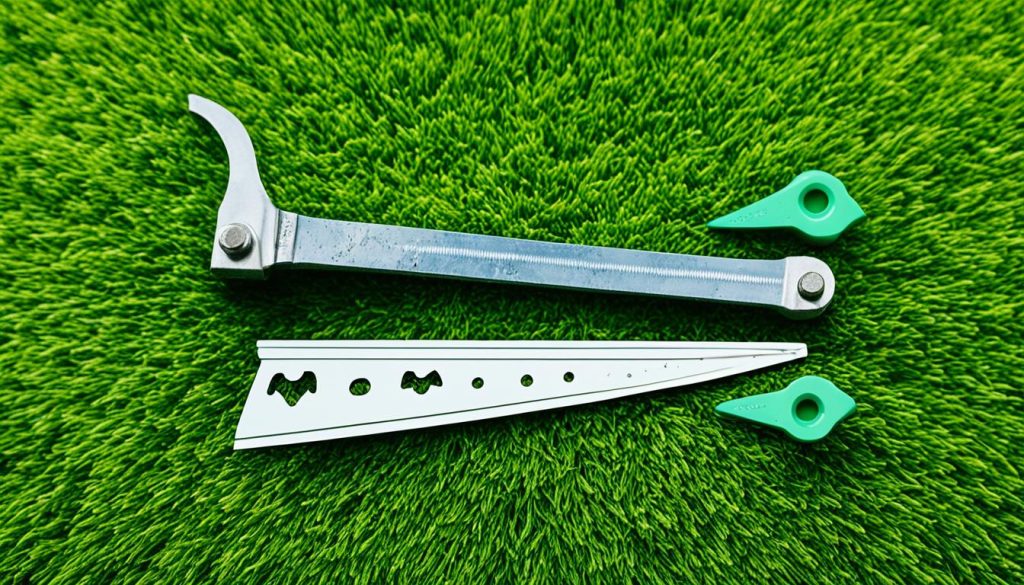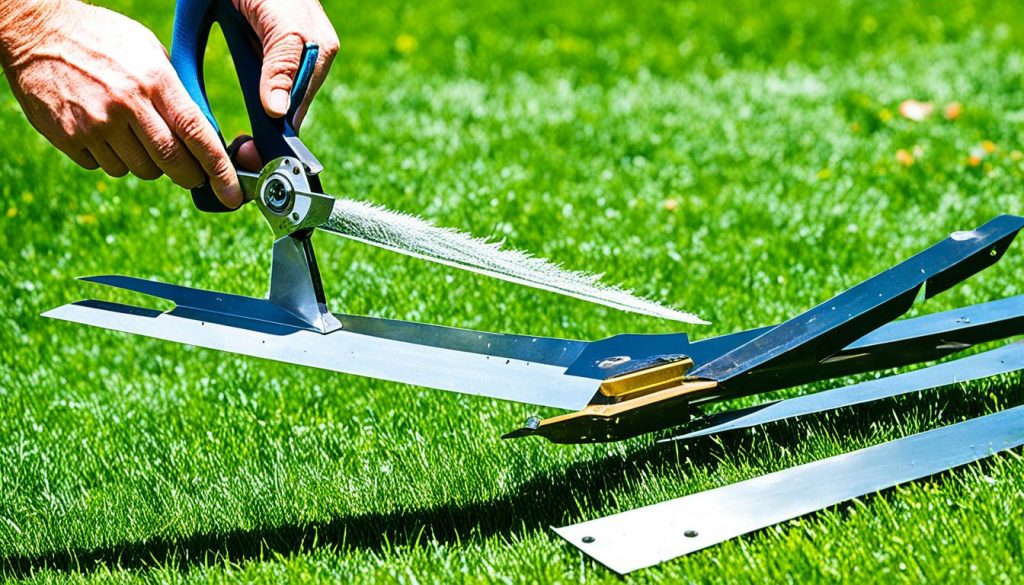Have you ever wondered why your lawn doesn’t look as neat and uniform as your neighbor’s, even though you both mow regularly? It could be a result of unbalanced lawn mower blades. While often overlooked, blade balance plays a crucial role in the performance and longevity of your mower.
Unbalanced blades can cause vibrations, uneven cuts, and even damage to your mower’s engine and components. But fear not! With a few simple steps, you can easily balance your lawn mower blades and achieve a pristine cut for a healthier, more attractive lawn.
Key Takeaways:
- Regularly inspect your lawn mower blades for signs of damage or wear.
- Sharpen your blades regularly to maintain their cutting efficiency.
- Check the balance of your blades to minimize vibrations and ensure a smooth cut.
- Properly reinstall the blades after cleaning or sharpening.
- Maintain a schedule for blade maintenance to promote the longevity of your mower.
Removing and Cleaning the Blade
When it comes to maintaining your lawn mower, removing and cleaning the blade is a vital step. Not only does it help ensure optimal cutting performance, but it also extends the life of your mower. Follow these steps to safely remove and clean your lawn mower blade:
- Disconnect the power source: Before starting any work, make sure the power source is disconnected. For gas mowers, remember to drain the gas tank to avoid any potential spills or accidents.
- Position the mower: Turn the mower on its side with the air filter and carburetor facing up. This position allows for easier access to the blade.
- Mark the blade: To ensure proper reinstallation, mark the bottom of the blade before removing it. You can use a marker or a piece of tape for this purpose.
- Remove the blade: Using a ratchet or wrench, loosen and remove the nut that holds the blade in place. Be careful not to damage the threads or the blade itself.
- Clean the blade: Take a rag or a microfiber cloth and wipe down the blade to remove any grass clippings, dirt, or debris. For stubborn buildup, use a brush and some penetrating oil to gently scrub away the residue.
Image:
Cleaning your blade not only ensures better cutting performance but also helps prevent rust and corrosion. By following these steps, you’ll keep your lawn mower in top shape and ready for the next mowing session.
| Benefits of removing and cleaning the blade: |
|---|
| 1. Improved cutting performance |
| 2. Prevention of rust and corrosion |
| 3. Extended lifespan of the mower |
| 4. Removal of debris and buildup |
Sharpening the Lawn Mower Blade
Properly sharpening your lawn mower blade is essential for maintaining a clean and precise cut. By choosing the right tools and following the correct techniques, you can ensure that your blade remains sharp and efficient.
When it comes to sharpening your lawn mower blade, there are a few tools you can utilize, depending on your preference and availability. These include:
- Metal file
- Blade sharpener
- Bench grinder
- Angle grinder
Before you begin sharpening, securely clamp the blade to prevent any unwanted movements. It is crucial to sharpen the cutting edge at a consistent 45-degree angle. This angle allows for optimal cutting performance and grass health.
It is recommended to sharpen the blade from the top side of the cutting edge, using single directional strokes. This technique ensures a clean sharpening process without causing any damage to the blade. Follow the natural angle of the blade and make sure to even out any rough spots that may hinder its performance.
Most blades can be adequately sharpened with less than 50 strokes of the file. However, it is essential to pay attention to the blade’s condition and adjust the sharpening process accordingly. Repeat the sharpening process for the other edge of the blade to ensure a balanced and uniform cut.
Sharpening the Lawn Mower Blade – Step by Step:
- Securely clamp the blade to prevent any movement.
- Sharpen the cutting edge at a consistent 45-degree angle.
- Use single directional strokes from the top side of the cutting edge.
- Even out any rough spots by following the natural angle of the blade.
- Repeat the process for the other edge of the blade.
With these simple steps, you can effectively sharpen your lawn mower blade and ensure a clean and precise cut for your lawn.
Checking the Blade Balance
To ensure optimal performance and prevent potential damage to your lawn mower, it is essential to check the balance of the blade. A balanced blade helps reduce vibrations during operation, leading to a smoother cut and improved longevity of your mower. Follow these steps to check the balance and achieve precise blade balancing:
Step 1: Prepare the Tools
Before you begin, gather the following tools:
- Screwdriver
- Blade balancer
Step 2: Position the Blade
Support the blade under its center using a screwdriver as a makeshift scale. Make sure the blade is in a horizontal position.

Step 3: Check for Balance
With the blade supported by the screwdriver, observe its behavior. The blade should balance on the tip or handle. If it dips in either direction, it indicates that the blade is unbalanced.
Step 4: Identify the Heavier Side
To identify the heavier side of the blade, repeat the balance test after flipping the blade. The side that consistently dips lower is the heavier side.
Step 5: Achieve Precise Blade Balancing
Use a blade balancer to achieve precise balancing. The blade balancer helps determine the exact amount of weight that needs to be added or removed from the heavier side of the blade. Make necessary adjustments until the blade remains balanced when tested.
Step 6: Recheck the Balance
After making adjustments, recheck the balance using the screwdriver. The blade should now balance evenly and not dip in any direction.
| Tools | Steps |
|---|---|
| Screwdriver | Position the blade |
| Blade balancer | Achieve precise balancing |
By checking and balancing your lawn mower blade, you can ensure a smooth and efficient mowing experience while maintaining the integrity of your machine. Regularly inspect and balance your blade to promote optimal performance.
Reinstalling the Blade
To ensure proper functioning and cutting performance of your lawn mower, it’s important to know how to reinstall the blade correctly. Follow these steps to reinstall the blade securely:
Clean the Area Under the Mower
Before reinstalling the blade, take a moment to clean the area beneath the mower. Use a small brush or your hands to remove any debris or grass clippings that may have accumulated. This ensures a clean and clear space for the blade to operate smoothly.
Insert the Blade Correctly
Identify the marked side of the blade, which is usually indicated by a stamp or label. Ensure the marked side is facing up when inserting the blade onto the bolt. This is important for proper cutting and alignment when you start mowing your lawn.
Tighten the Nut Securely
Use a socket wrench to tighten the nut securely. Ensure it is tightened enough to prevent any wobbling or loosening during operation, but be careful not to overtighten and damage the blade or bolt. A well-secured blade ensures safe and efficient mowing.
Reconnect Spark Plug Wire and Power Source
Once the blade is securely attached, reconnect the spark plug wire to its original position. This ensures that power can be properly supplied to the mower’s engine. If you previously disconnected any power sources, such as batteries or power cords, make sure to reconnect them as well.
Check the Gas Tank
If you use a gas-powered mower, check the gas tank to ensure it is filled with the appropriate amount of fuel. Refill if necessary, following the manufacturer’s recommendations for your mower model. A well-filled gas tank ensures uninterrupted mowing and smooth operation.
Test the Mower
Before you start your mowing session, it’s crucial to test the mower to ensure it starts smoothly. Follow the manufacturer’s instructions for starting your specific mower model. Listen for any unusual sounds or vibrations that may indicate improper blade installation. If everything sounds and feels right, you’re ready to start mowing your lawn.
https://www.youtube.com/watch?v=4OoL9hzi914
By following these steps, you can safely and effectively reinstall the blade of your lawn mower. A properly installed and secured blade is essential for achieving a clean, even cut and maintaining the health of your lawn.
Maintaining Your Mower Blade
Regular maintenance is key to ensuring optimal performance and longevity for your lawn mower blade. By implementing a proper maintenance routine, you can keep your blade sharp and ready to tackle your mowing needs. Here are some essential tips for maintaining your mower blade:
Sharpening Frequency
- Sharpen the blades every 20 to 25 hours of use or two to three times during the mowing season.
- This frequency can vary based on how frequently and for how long you mow.
Keeping a Spare Blade
To ensure you always have a sharp blade available, it’s advisable to keep a spare one on hand. Having a backup blade allows you to swap out a dull blade quickly, minimizing downtime and maximizing efficiency in your lawn care routine.
Benefits of Regular Blade Sharpening
Regularly sharpening your mower blade offers several advantages:
- Maintains a healthy lawn: A sharp blade provides a clean cut, promoting lawn health by minimizing stress on the grass.
- Extends mower life: When the blade is sharp, the mower’s engine doesn’t have to work as hard, reducing strain on the machine and potentially extending its lifespan.
Remember, a well-maintained blade is crucial for achieving a clean, precise cut and maintaining the overall health of your lawn. Investing time in proper lawn mower blade maintenance pays off in the form of a beautifully manicured lawn and long-lasting equipment.

Using proper maintenance techniques, you can keep your mower blade in top shape, ensuring optimal performance for seasons to come.
Importance of Balanced Lawn Mower Blades
Properly balanced lawn mower blades play a vital role in maintaining a well-functioning mower and achieving a professional-looking cut. Balancing the blades reduces vibrations, prevents potential damage to the mower’s internal components, and ensures a smooth and even cutting experience.
When mower blades become unbalanced, they create excessive vibrations that can have detrimental effects on the mower’s performance and longevity. These vibrations can cause wear and tear on the blade shaft, spindle, and engine, leading to costly repairs and a shorter lifespan for your mower.
Aside from the mechanical implications, unbalanced blades also impact the quality of your lawn’s appearance and health. Balanced blades provide a cleaner and more precise cut, allowing the grass to recover more effectively after mowing. With balanced blades, you’ll notice a reduction in torn grass blades and frayed grass edges, resulting in a healthier and more vibrant lawn.
To emphasize the importance of balanced mower blades, consider the following benefits:
- Reduced vibrations during mowing, leading to a smoother and more comfortable operation
- Prevention of premature wear and tear on the mower’s internal components
- Improved quality of cut, resulting in a neater appearance and healthier grass
Now that you understand the significance of balanced lawn mower blades, it’s essential to prioritize regular maintenance and inspections. By dedicating a little time to balance your blades, you can extend the life of your mower and enjoy the satisfaction of a well-manicured lawn.
Fixing Unbalanced Lawn Mower Blades
If you find that your mower blades are unbalanced, there are several steps you can take to correct this issue and ensure smooth operation. By removing excess weight from the heavier side of the blade, you can restore balance and prevent vibrations during mowing.
One way to fix unbalanced lawn mower blades is by reshaping the blade with a grinder. Carefully grind down the heavier side of the blade until it matches the weight of the lighter side. This process helps remove excess metal and restores balance to your mower blade.
Another method is to sharpen the heavier side of the blade. By removing a slight amount of metal through sharpening, you can reduce the weight imbalance and achieve a balanced blade. Use a sharpening tool or file to carefully sharpen the edge of the blade on the heavier side.
After making adjustments to the blade, it’s crucial to test the balance using a blade balancer. A blade balancer provides an accurate measurement of the blade’s balance by indicating whether it tilts towards one side or remains level. Place the blade on the blade balancer, and if it dips or tilts, it means that more adjustments are necessary.
Steps to Fix Unbalanced Lawn Mower Blades:
- Remove excess weight from the heavier side by reshaping the blade with a grinder.
- Alternatively, sharpen the heavier side of the blade to reduce the weight imbalance.
- Test the balance using a blade balancer to ensure the blade is level and does not tilt.
- Repeat the process if the blade still tips in either direction.
By following these steps, you can effectively fix unbalanced lawn mower blades and restore optimal performance to your mower. Balancing the blades not only improves the quality of your lawn’s cut but also helps prevent damage to the mower itself.
Conclusion
Properly balancing your lawn mower blades is essential for maintaining the performance and longevity of your mower. By following a few key techniques, you can ensure that your blades are always in optimal condition for a smooth and efficient cutting experience.
First and foremost, it’s important to regularly inspect your mower blades for signs of wear and tear. Look out for dents, nicks, and other damages that may affect the blade’s balance. Make sure to sharpen your blades at least twice per season or after 25 hours of use, and more frequently if they become damaged from hitting rocks or other debris.
Checking the balance of your blades is equally important. Use a simple test by supporting the blade under its center with a screwdriver, and observe if it balances on the tip or handle. If it tilts to one side, it needs adjustment. A blade balancer can help you achieve precise balance. Remember that a well-balanced blade prevents excessive vibrations and potential damage to your mower.
By maintaining a regular schedule of inspection, sharpening, and balance checking, you can effectively balance your lawn mower blades and ensure a smooth cutting experience while promoting the health and vigor of your lawn.





